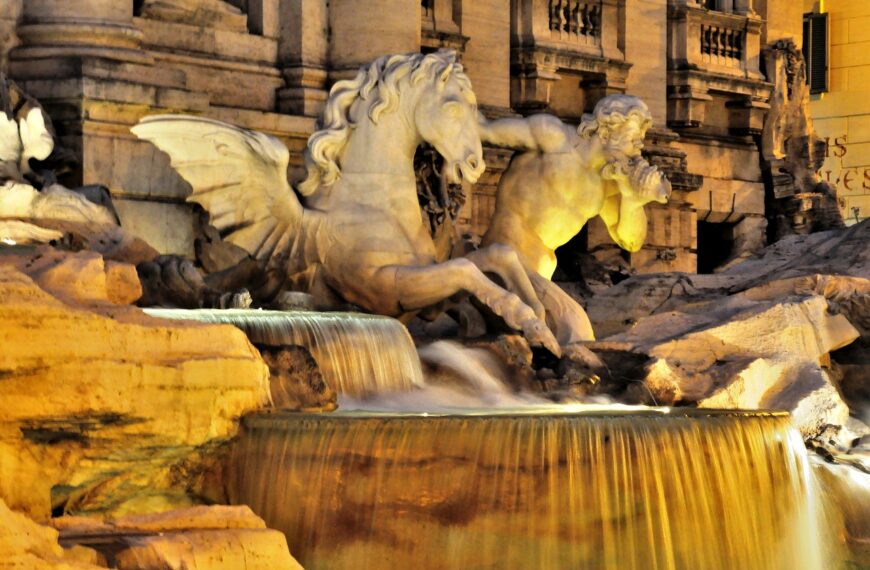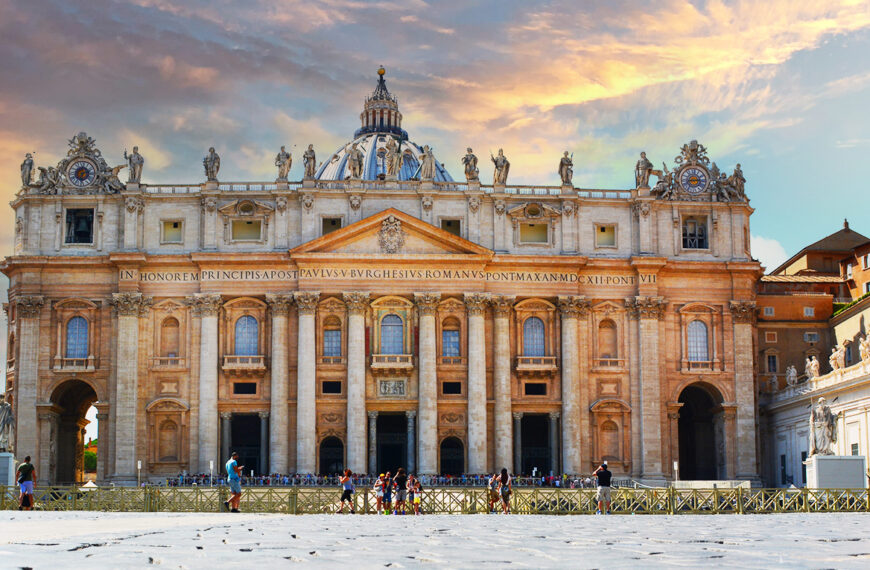- Tourist Information
- Map
- What is the history of Saint Paul’s Basilica?
- Why is the Basilica of Saint Paul important in the history of Christianity?
- What does the architecture of the basilica look like?
- What famous works of art are inside the basilica?
- What are the important relics and relics kept in the Basilica of Saint Paul?
- Is Saint Paul’s tomb in the Basilica?
- Are there legends associated with Saint Paul’s Basilica?
- Saint Paul in chains
- The relics of Saint Paul
- The miraculous fire
- Constantine’s dream
- Saint Paul and the dragon
Tourist Information
| Construction Year | 386 AD |
| Type | Basilica, Church, UNESCO Site |
| Getting there | Metro station: Basilica San Paolo, line B. Buses: 23 and 271 |
| When to visit | 7.00 am – 6.30 pm |
| Short History | When Paul the Apostle was executed in the first century AD in Rome, his followers built a shrine over his grave. In 324 BC a small church was consecrated on the same grounds, which was later demolished in 386 BC to make space for the construction of a larger and more beautiful basilica, completed in 395 BC. |
| Location | 186, Via Ostiense, 00146, Rome, Italy, Europe |
Map
What is the history of Saint Paul’s Basilica?
In the 1st century AD, Paul (also known as Paul) was executed in Rome, and his relatives built a shrine over his tomb.
Later, in 324 AD, a small church was built nearby, which was finally demolished in 386 AD to make way for a much larger, basilica-style church that had been planned since 295 AD.
The Basilica of Saint Paul, also known as the Papal Basilica of Saint Paul the Apostle Outside the Walls was built in the 19th century after the original church suffered significant fire damage. The name of the edifice derives from the fact that the Basilica was built outside the walls, which in ancient times surrounded all of Rome.
Emperor Constantine was the one who ordered the construction of the basilica on the place where the descendants of the apostles built a memorial monument.
The basilica is one of the four papal basilicas in Rome. The Pope often presides over important Masses held in the basilica.
Why is the Basilica of Saint Paul important in the history of Christianity?
The Basilica of Saint Paul is important in the history of Christianity because it marks the burial place of Saint Paul, one of the most important apostles of Jesus Christ and the author of several epistles in the New Testament.
What does the architecture of the basilica look like?
The architecture of the basilica is impressive and has neoclassical elements. The main facade has a colonnade with Doric columns. Inside, there is an imposing dome and a series of religious frescoes and mosaics.
Within the basilica, you can find a beautiful garden with a fountain in the center, surrounded by columns and covered walkways. Some of these columns are adorned with pieces of golden mosaic and the soft afternoon sunlight creates a peaceful atmosphere in this amazing location. Despite a fire in 1823 AD, this area remained unscathed.

After the fire, many countries generously donated funds for the restoration of the basilica, which reopened in 1840 AD. The entire structure has been declared a national monument.
What famous works of art are inside the basilica?
Inside the basilica, you can admire a number of works of art, including mosaics depicting scenes from the life of Saint Paul and other important religious subjects. You will also find sculptures and other religious art.
Portraits of the Popes: In the Basilica of Saint Paul in Rome, there is an impressive collection of portraits of the Popes, which have been placed over time to commemorate and present the history of the papacy. These portraits are generally made in the form of paintings or mosaics and represent successive Catholic popes.
Each pope is represented in chronological order beginning with Saint Peter, considered the first pope, and continuing to the current pope. The portrait of the current pope is illuminated.

Each pope is represented in chronological order beginning with Saint Peter, considered the first pope, and continuing to the current pope. The portrait of the current pope is illuminated.
Great fresco of the dome: The dome of the basilica is decorated with an impressive fresco depicting scenes from the life of Saint Paul and other important religious events. This fresco covers a vast area and is one of the main artistic attractions of the basilica.
The mosaics of the apses: The apses of the basilica are decorated with spectacular mosaics depicting scenes from the life of Jesus Christ and scenes from the history of the Church.
Statue of Saint Paul: In the courtyard at the entrance to the basilica there is a huge statue of Saint Paul, made of marble. This is an iconic representation of the saint.

Chapel of Saint Peter and Paul: This chapel is decorated with mosaics representing Saint Peter and Saint Paul. It also houses relics of the two apostles.
Main Altar: The altar of the basilica is an outstanding example of sacred art and is used for the celebration of important liturgies. It is often decorated with flowers and candles during religious ceremonies.
Marble stars with the names of saints: The floor of the basilica is strewn with marble stars bearing the names of saints. They are arranged in an artistic way and can be considered a symbol of the communion of saints.
Basilica organ: The monumental organ in St. Paul’s Basilica is another important artistic achievement. This is used during services to provide uplifting music.
Basilica Atrium: The exterior atrium is one of the most remarkable parts of St. Paul’s Basilica. It consists of 150 columns and from here visitors can see the facade of the basilica covered by an enormous gold mosaic, built between 1854 and 1874, which reflects the sun’s rays. The center of the portico houses a colossal statue of Saint Paul.


What are the important relics and relics kept in the Basilica of Saint Paul?
The basilica houses the relics of Saint Paul, such as part of the pediment above his tomb and the chains that bound him in prison. You can also see the tomb of Saint Paul in the basement of the basilica.

Is Saint Paul’s tomb in the Basilica?
In the middle of the transept, in 2006, Vatican archaeologists confirmed the presence of a white marble sarcophagus under the altar, probably containing the relics of Saint Paul the Apostle. The sarcophagus has not been removed from its original location so that only one of its sides is visible. The basilica also houses part of the pediment above his tomb and the chains that bound him in prison.

Are there legends associated with Saint Paul’s Basilica?
Saint Paul in chains
A legend says that during his detention in Rome, Saint Paul was kept in chains before his martyrdom. His chains are said to have been kept as relics and according to tradition, they had miraculous healing powers.
The relics of Saint Paul
The basilica was built on the site where Saint Paul is believed to have been buried. This is why it is so important in Christianity. Legend has it that during the reign of Emperor Constantine the Great, the relics of Saint Paul were discovered and brought to the surface from his tomb under the basilica.
The miraculous fire
It is said that during a devastating fire in the basilica in the 19th century, the flames left a cross untouched. This was interpreted as a miraculous sign and confirmation of divine protection over the basilica.
Constantine’s dream
Another legend relates that Emperor Constantine the Great had a dream in which Saint Paul appeared to him and asked him to build a church on the site of his tomb. After having this dream, Constantine ordered the construction of Saint Paul’s Basilica.
Saint Paul and the dragon
According to a medieval legend, Saint Paul was in Rome during his imprisonment, and the Christian church was still in the stage of spreading and consolidation. Around this time, it is said that a ferocious and menacing dragon had begun to terrorize the city. This dragon was particularly dangerous and brought suffering and destruction in its path.
When St. Paul learned of this dragon and the evil it was causing, he decided to intervene in the name of Christ and Christianity. St. Paul bravely walked before the dragon and with his strong faith uttered a prayer or invocation to God. At that moment, according to legend, a miracle occurred.
Saint Paul was able to subdue the dragon with the power of his faith and prayer, and the dragon was brought under control. He no longer posed a threat to the city, and the population was freed from his fear. This act of courage and faith strengthened faith in Christianity and brought people to Christ.
This legend illustrates the power of faith and God in the face of evil and threats and is an example of the miracles attributed to St. Paul during his lifetime.





















